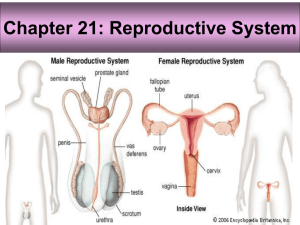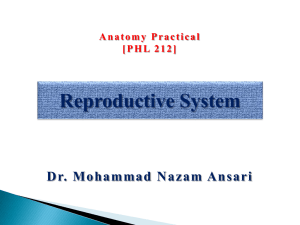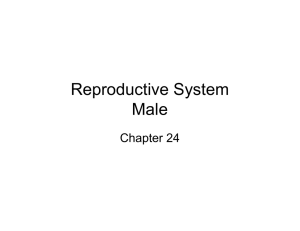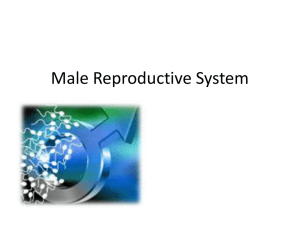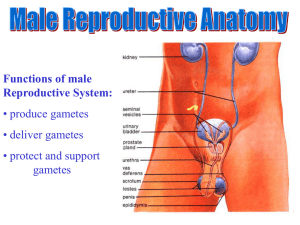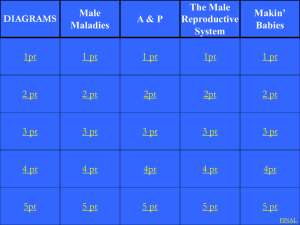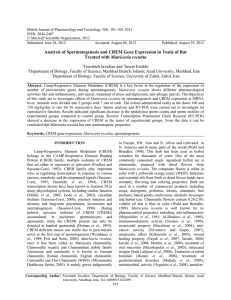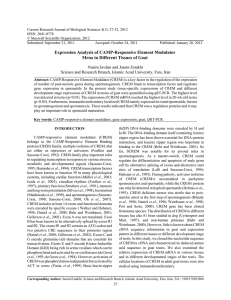Research Journal of Applied Sciences, Engineering and Technology 7(9): 1883-1886,... ISSN: 2040-7459; e-ISSN: 2040-7467
advertisement
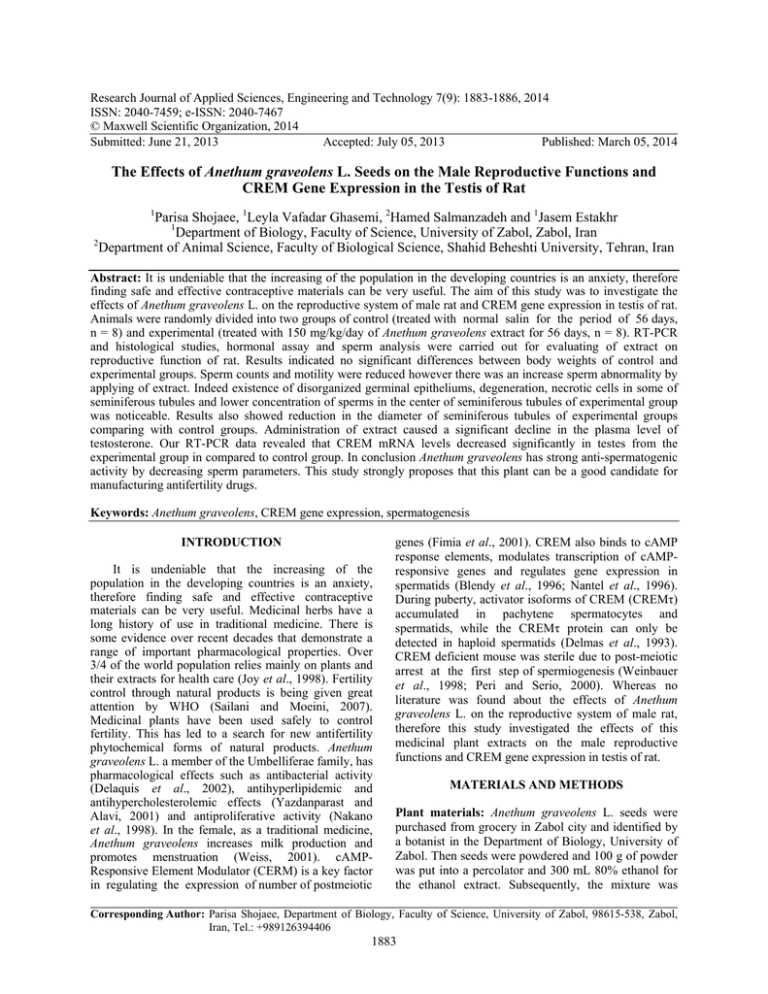
Research Journal of Applied Sciences, Engineering and Technology 7(9): 1883-1886, 2014 ISSN: 2040-7459; e-ISSN: 2040-7467 © Maxwell Scientific Organization, 2014 Submitted: June 21, 2013 Accepted: July 05, 2013 Published: March 05, 2014 The Effects of Anethum graveolens L. Seeds on the Male Reproductive Functions and CREM Gene Expression in the Testis of Rat 1 Parisa Shojaee, 1Leyla Vafadar Ghasemi, 2Hamed Salmanzadeh and 1Jasem Estakhr 1 Department of Biology, Faculty of Science, University of Zabol, Zabol, Iran 2 Department of Animal Science, Faculty of Biological Science, Shahid Beheshti University, Tehran, Iran Abstract: It is undeniable that the increasing of the population in the developing countries is an anxiety, therefore finding safe and effective contraceptive materials can be very useful. The aim of this study was to investigate the effects of Anethum graveolens L. on the reproductive system of male rat and CREM gene expression in testis of rat. Animals were randomly divided into two groups of control (treated with normal salin for the period of 56 days, n = 8) and experimental (treated with 150 mg/kg/day of Anethum graveolens extract for 56 days, n = 8). RT-PCR and histological studies, hormonal assay and sperm analysis were carried out for evaluating of extract on reproductive function of rat. Results indicated no significant differences between body weights of control and experimental groups. Sperm counts and motility were reduced however there was an increase sperm abnormality by applying of extract. Indeed existence of disorganized germinal epitheliums, degeneration, necrotic cells in some of seminiferous tubules and lower concentration of sperms in the center of seminiferous tubules of experimental group was noticeable. Results also showed reduction in the diameter of seminiferous tubules of experimental groups comparing with control groups. Administration of extract caused a significant decline in the plasma level of testosterone. Our RT-PCR data revealed that CREM mRNA levels decreased significantly in testes from the experimental group in compared to control group. In conclusion Anethum graveolens has strong anti-spermatogenic activity by decreasing sperm parameters. This study strongly proposes that this plant can be a good candidate for manufacturing antifertility drugs. Keywords: Anethum graveolens, CREM gene expression, spermatogenesis INTRODUCTION It is undeniable that the increasing of the population in the developing countries is an anxiety, therefore finding safe and effective contraceptive materials can be very useful. Medicinal herbs have a long history of use in traditional medicine. There is some evidence over recent decades that demonstrate a range of important pharmacological properties. Over 3/4 of the world population relies mainly on plants and their extracts for health care (Joy et al., 1998). Fertility control through natural products is being given great attention by WHO (Sailani and Moeini, 2007). Medicinal plants have been used safely to control fertility. This has led to a search for new antifertility phytochemical forms of natural products. Anethum graveolens L. a member of the Umbelliferae family, has pharmacological effects such as antibacterial activity (Delaquis et al., 2002), antihyperlipidemic and antihypercholesterolemic effects (Yazdanparast and Alavi, 2001) and antiproliferative activity (Nakano et al., 1998). In the female, as a traditional medicine, Anethum graveolens increases milk production and promotes menstruation (Weiss, 2001). cAMPResponsive Element Modulator (CERM) is a key factor in regulating the expression of number of postmeiotic genes (Fimia et al., 2001). CREM also binds to cAMP response elements, modulates transcription of cAMPresponsive genes and regulates gene expression in spermatids (Blendy et al., 1996; Nantel et al., 1996). During puberty, activator isoforms of CREM (CREMτ) accumulated in pachytene spermatocytes and spermatids, while the CREMτ protein can only be detected in haploid spermatids (Delmas et al., 1993). CREM deficient mouse was sterile due to post-meiotic arrest at the first step of spermiogenesis (Weinbauer et al., 1998; Peri and Serio, 2000). Whereas no literature was found about the effects of Anethum graveolens L. on the reproductive system of male rat, therefore this study investigated the effects of this medicinal plant extracts on the male reproductive functions and CREM gene expression in testis of rat. MATERIALS AND METHODS Plant materials: Anethum graveolens L. seeds were purchased from grocery in Zabol city and identified by a botanist in the Department of Biology, University of Zabol. Then seeds were powdered and 100 g of powder was put into a percolator and 300 mL 80% ethanol for the ethanol extract. Subsequently, the mixture was Corresponding Author: Parisa Shojaee, Department of Biology, Faculty of Science, University of Zabol, 98615-538, Zabol, Iran, Tel.: +989126394406 1883 Res. J. Appl. Sci. Eng. Technol., 7(9): 1883-1886, 2014 filtered and concentrated under pressure by a rotary and desiccators. The yield (w/w) of ethanol extract was 6.5% (g/g). The extract was dissolved in normal salin and administrated oraly into rats. Animals and extract administrations: Healthy adult male wistar rats (200-300 g), purchased from Razi Institute (Shiraz, Iran) and were housed in animal house, at ambient room temperature with a controlled light and dark period of 12 h. The animals were fed with a standard laboratory food (pellets) and provided adlibitum. They were weighted before and after the study. After 7 days for adapting to the new environment, the rats were randomly divided into two groups of control (treated with normal salin for the period of 56 days, n = 8) and experimental (treated with 150 mg/kg/day of Anethum graveolens extract for 56 days, n = 8) groups. Tissue preparation and hormone assay: At the end of the treatment period, the pentobarbital sodium (40 mg/kg i.p.) was administered for anesthesia. Blood samples was collected from abdominal aorta, separated after centrifugation (3000 rpm) and stored at -80°C, to carry out the hormonal assays. Hormone levels were measured by radioimmunoassay coat-A-count kit (diagnostic products corporation, LA, Calif) using Packard Cobra gamma-counter. Testes were removed, cleared of adhering tissue and weighed. The epididymis was removed, used for sperm analysis. Some of the testes samples were frozen before RT-PCR and others were fixed in formalin 10%. Then, tissue processing for H and E staining and histopathological studies was carried out. Sperm analysis: For analysis, epididymis was exposed through scrotal incision and sperms were expressed out by cutting the distal end of the caudal epididymal tubule. Spermatozoa (with epididymial fluid) were diluted with physiological salin and their motilities and morphologlical structures were studied. Counting was carried out as per the method of Zaneveld and Polakoski (1977). Sperm suspension was placed on both sides of Neubauer’s hemocytometer and allowed to settle in a humid chamber, for 1 h. The number of spermatozoa, in the appropriate squares of the hemocytometer, was counted. RNA isolation and RT-PCR: Total RNA from the testes were extracted by RNeasy Mini Kit (QIAgen, USA.) Total RNA samples were analyzed using gel electrophoresis. The final amount of RNA was estimated by determining the optical density at 260 nm. First strand cDNA synthesis with total RNA was performed using reverse transcriptase. Subsequently, PCR-amplification was performed. The sequence of CREM primers were 5’-GATTGAAGAAGAAAA ATCAGA-3’ (forward primers, exon B) and 5’-TT GACATATTCTTTCTTCTT-3’ (reverse primer, exon H), while for rat GAPDH, 5’-GGTGGTAGCAGT GAA TGA-3’ and 5’-CCACGTTTCCTTTGTATCT-3’ was used. The PCR products were separated on 1.5% agarose gels, visualized under UV light and analyzed using NTSYS software. Statistical analysis: Data were expressed as mean± standard deviation. Student’s t-test was used to compare means. A level of p<0.05 was considered as statistically significant. RESULTS Body and organ weights: Treatments with Anethum graveolens seeds extract had no effect on the survival of the male rats. Results showed no significant differences between body weights of the rats of control and experimental groups (Table 1). However, there was a significant reduction in the weights of testes of experimental group, compared with control group (Table 1). Sperm analysis: Administration of extract (150 mg/kg/day) for 56 consecutive days, has significantly reduced sperm counts and motility and increased sperm abnormalities in experimental group in comparison with control group (p<0.05) (Table 1). Histopathological studies: Results from histological studies showed normal seminiferous tubules in control group (Fig. 1a). Degenerated and necrotic cells were observed in some seminiferous tubules of both experimental groups. In animals that received 150 mg/kg/day extract for 56 days, there were seen disorganized germinal epitheliums in the most of seminiferous tubules (Fig. 1b and c). From the histological studies it is observable truly that concentration of sperm in the center of seminiferous tubules of experimental groups has been reduced (Fig. 1). Studies also exhibited that there is a reduction in the diameter of seminiferous tubules of experimental groups comparing with control groups (Table 2 and Fig. 2). Table 1: Effects of Anethum graveolens seed extract on body weight, testis weight, sperm parameters in rats Testis weight Groups Body weight (g) (mg/100 g) Sperm count×105/mL Sperm motility Control 219.67±2.45 0.486±0.032 51.29±1.21 75.32±1.07 Exprimental 217.89±2.23 0.451±0.011* 42.34±1.76* 64.63±1.32* n: 8; *: p<0.05 compared with the corresponding controls 1884 Sperm abnormalities 27.51±0.88 34.65±1.11* Res. J. Appl. Sci. Eng. Technol., 7(9): 1883-1886, 2014 Table 2: Effects of Anethum graveolens extract on the diameter of seminiferous tubule (mm) Groups Diameter of seminiferous tubule (mm) Control 0.29±0.34 Experimental 0.26±0.18* n: 8; *: p<0.05 compared with the corresponding controls Table 3: Effects of 150 mg/kg/day of Anethum graveolens extract (for 56 days) on sexual hormones’ level in rat Groups Testosterone FSH level LH level level (ng/mL) (MIU/M) (MIU/M) Control 0.823±0.076 0.177±0.013 0.399±0.076 Experimental 0.689±0.032* 0.178±0.033 0.404±0.082 n: 8; *: p<0.05 compared with the corresponding controls Fig. 3: Relative m RNA expression of CREM. There is a significant decline in the expression of CREM in the testes of experimental group compare to control group (a) was performed to evaluate the effect of Anethum graveolens seed extract (150 mg/kg/day) on CREM gene expression in rat testes. The CREM fragment was detected at 520 bp. CREM mRNA levels decreased significantly in testes from the experimental group in compared to control (Fig. 3). (b) DISCUSSION (c) Fig. 1: Histological studies of testes of rats treated with Anethum graveolens seed extract 56 days, (a) normal seminiferous tubules of control group, (b and c) degenerated, disorganized germinal epithelium and necrotic cells in some seminiferous tubules of both experimental groups H&E, 40x (a) (b) Fig. 2: Reduction in the diameter of seminiferous tubule of experimental groups H&E, 40x Plasma hormonal levels: Plasma level of testosterone was significantly decreased in treated group compared to the control (p<0.05). There was an increase in the plasma level of LH in treatment group, but not significant. Results also showed a normal level of FSH in two groups (Table 3). CREM mRNA levels in rat testes: Reverse Transcription Polymerase Chain Reaction (RT-PCR) Whereas no attempt appears to have been made, so far, to determine the effects of Anethum graveolens on male rat fertility with emphasis on CREM gene expression, we were interested in doing this research. Interestingly, results showed that administration of Anethum graveolens seed extract creates marked reduction in the testes weights, sperm counts and motilities compared with control group. Increases in the number of abnormal and disorganized sperms were remarkable. Reduction in testicular weight, which is known to be mostly related to the number of spermatozoa. Considering the results of sperm analysis and histopathological studies, a decrease on the weights of testes of experimental groups can be expected. A significant reduction in the number and motility of sperm (p<0.05) was observed in experimental group, which could be due to the influence of the extract on the cell cycle, cell division and expression of genes necessary for the spermatogenesis. It is also possible that these changes might be result of changes in the microenvironment of epididymis and creation of a toxic microenvironment presence in Anethum graveolens seed extract, thus influencing sperm count and motility. Histophatological studies revealed some change in the seminiferous tubules of experimental group including; disorganized germ epithelium, degenerated, presence of necrotic cells and reduction in the diameter of seminiferous tubule. These alterations might be caused by cytotoxicity of Matricaria recutita extract. In the present study hormonal measurement showed a significant reduction in testosterone level. Testosterone is synthesized from cholesterol in the leydig cells. The secretion of testosterone is under the control of LH and the mechanism by which LH 1885 Res. J. Appl. Sci. Eng. Technol., 7(9): 1883-1886, 2014 stimulates the leydig cells involves increased formation of cyclic AMP via the serpentine LH receptore (Kati et al., 2006). Testosterone exerts an inhibitory feedback effect on pituitary LH secretion (Kati et al., 2006). It appears that reduction in testosterone level cause a reduction in inhibitory action of testosterone on LH secretion, thus the secretion of LH increase. The level of FSH was normal in three groups. Along with testosterone, FSH is responsible for the maintenance of gametogenesis. FSH acts on the sertoli cells to facilitate the spermatogenesis (Kati et al., 2006). CREM is essential for spermatogenesis and males lacking functional CREM gene are sterile due to their round spermatid maturation arrest (Nantel et al., 1996). The CREM gene encodes the transcription activator CREM, which is highly expressed in male germ cells (Fimia et al., 2001; Blendy et al., 1996; Nantel et al., 1996) and regulates the expression of many important post-meiotic genes (Delmas et al., 1993; Weinbauer et al., 1998). In the present study, rats treated with Anethum graveolens seed extract displayed significant reduction in CREM mRNA level, compare with control group. Given the results, it is concluded that Anethum graveolens has specific inhibitory effects on sperm parameters and reproductive functions of male rats which is probably performed by a reduction of the level of CREM expression. ACKNOWLEDGMENT We are grateful to University of Zabol, for supporting this study. We are also thankful to staff of Medicinal Plants and Drugs Institute, Shahid-Beheshti University for providing necessary facilities for this study. REFERENCES Blendy, J.A., K.H. Kaestner, G.F. Weinbaure, E. Nieschlag and G. Schuetz, 1996. Severe impairment of spermatogenesis in mice lacking the CREM gene. Nature, 380: 162-165. Delaquis, P.J., K. Stanich, B. Girard and G. Mazza, 2002. Antimicrobial activity of individual and mixed fractions of dill, cilantro, coriander and eucalyptus essential oils. Int. J. Food Microbiol., 74: 101-109. Delmas, V., F. van der Hoorn, B. Mellström, B. Jégou and P. Sassone-Corsi, 1993. Induction of CREM activator proteins in spermatids: Downstream targets and implications for haploid germ cell differentiation. Mol. Endocrinol., 7(11): 1502-1514. Fimia, G.M., A. Morlon, B. Macho, D. De Cesare and P. Sassone-Corsi, 2001. Transcriptional cascades during spermatogenesis: Pivotal role of CREM and ACT. Mol. Cell Endocrinol., 179: 17-23. Joy, P.P., J. Thomas, S. Mathew and B.P. Skaria 1998. Medicinal plants. Kerala Agricultural University, Kerala, India Kati, L.M., I.M. Robert, O.M. Liza, F. Mark, M.R. David, G.S. Peter and J.M. Sarah, 2006. The relative roles of follicle-stimulating hormone and luteinizing hormone in maintaining spermatogonial maturation and spermiation in normal men. J. Clin. Endocr. Metab., 91: 3962-3969. Nakano, Y., H. Matsunaga, T. Saita, M. Mori, M. Katano and H. Okabe, 1998. Antiproliferative constituents in Umbelliferae plants II. Screening for polyacetylenes in some umbelliferae plants and isolation of panaxynol and falcarindiol from the root of heracleum moellendorffii. Biol. Pharm. Bull., 21(3): 257-61. Nantel, F., L. Monaco, N.S. Foulkes, D. Masuilier, M. Lemeur, K. Henriksen, A. Dierich, M. Parvinen and P. Sassone-Corsi, 1996. Spermiogenesis deficiency and germ cell apoptosis in CREMmutant mice. Nature, 380: 159-162. Peri, A. and M. Serio, 2000. The CREM system in human spermatogenesis. J. Endocrinol. Invest, 23: 578-583. Sailani, M.R. and H. Moeini, 2007. Effect of Ruta graveolens and Cannabis sativa alcoholic extract on spermatogenesis in the adult wistar male rats. Indian J. Urol., 23: 257-260. Weinbauer, G.F., R. Behr, M. Bergmann and E. Nieschlag, 1998. Testicular cAMP responsive element modulator (CREM) protein is expressed in round spermatids but is absent or reduced in men with rounding spermatic maturation arrest. Mol. Hum. Reprod., 4: 9-15. Weiss, R.F., 2001. Weiss's Herbal Medicine. Classic Edn., Thieme Publication, New York. Yazdanparast, R. and M. Alavi, 2001. Antihy perlipidaemic and antihy percholesterolaemic effects of Anethum graveolens leaves after the removal of furocoumarins. Cytobios, 105(410): 185-91. Zaneveld, L.J.D. and K.L. Polakoski, 1977. Collection and Physiccal Examination of the Ejaculate. In: Hafez, E.S.E. (Ed.), Techniques of Human Andrology. North Holand Biomedical Press, Amsterdam, Holland, pp: 147-156. 1886

